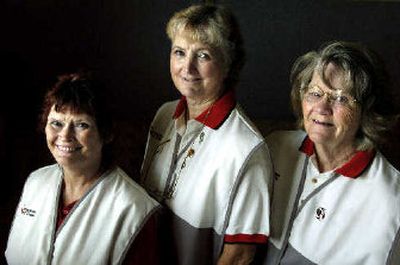Red Cross volunteer recalls month’s work at Utah shelter

LuAnn Stallcop of Otis Orchards watched dozens of Hurricane Katrina evacuees start over as she served nearly a month at a Red Cross shelter in Utah.
“We all were hoping these people have a chance to change their lives,” Stallcop, 65, said. “They were evacuees from the Dome and some who were rescued.
“Most had never seen mountains and had never lived anywhere without humidity. Some 354 decided to stay in Utah. They got jobs and were given furnished apartments free for a year. Some never had jobs before.”
Stallcop wrote down details about her Sept. 5-28 experiences working at a shelter for about 572 evacuees set up at Camp Williams, a National Guard training site 26 miles south of Salt Lake City. She went to the site along with six other Inland Northwest Red Cross volunteers.
She said evacuees arrived by airplane in the same clothes they had on during their ordeal in New Orleans. After being greeted by Red Cross volunteers and having their luggage checked by the National Guard, the groups were taken by bus to the base.
“They were given beds in the barracks, meals provided by the Southern Baptist Church, hot water and showers, and a community center equipped with large TVs, couches, books, puzzles, long tables of free phones to call any place and computers.”
Different businesses furnished food. State government services, job work forces, churches, the Salvation Army and Federal Emergency Management Agency were present, she said.
“Once the evacuees were there for a couple of days, they began to love it. Some told me that it was like going to heaven.”
She said Salt Lake community resources joined forces and offered trips that included a Harlem Globetrotters game, NASCAR, the state fair, mountain excursions, city tours, horseback riding, haircuts and shopping at malls.
“It was a wonderful lesson for all of us with the different cultures coming into play. We would smile at them and speak to them. At first they wouldn’t look us in the eyes, and they finally asked us why we were smiling at them. We told them that was the way it was in the West. Everyone smiles at everyone. Then they began to smile back.
“Some had never been out of New Orleans.”
At the shelter, evacuees had access to a large building filled with clothes, a medical team, mental health nurses, bank, post office, chapel, nursery and dental team.
“It turned into a small town with everything they would need to get them back on their feet.”
Stallcop added that a few people did create problems such as trying to bring drugs onto the base, but security was tight. Others had prison records and serious mental or medical problems, she said.
Some evacuees, mainly elderly, were determined to return to New Orleans, she said.
“I have read some Internet articles about the camps being like prisons. That is absolutely not correct. This was a wonderful place. People told us this was a very nice place to be.”
The media, the governor, state representatives and other officials came regularly to talk to evacuees, Stallcop added. Red Cross workers showed people how to use the computers, to register online to notify relatives.
“They asked questions like why didn’t the Red Cross rescue them? We told them that the Red Cross does not conduct search and rescue operations. We also cannot get relief aid into any location until the local authorities say it is safe.”
The shelter closed the night before Stallcop left, with evacuees finding new or temporary homes. She was touched by one story just before her departure: a wedding paid for by community well-wishers.
“This couple met when they got on the airplane at New Orleans to come to Salt Lake. What a happy ending. They are going to make their home in Salt Lake City.”
Stallcop is preparing to leave for more Red Cross volunteering, perhaps in November.